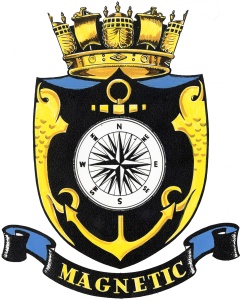HMAS Magnetic
Commissioned on 1 September 1942, HMAS Magnetic was a shore based naval depot in Townsville, Queensland - one of the many new naval stations that sprang up along the Australian coastline during the Pacific War. The name Magnetic covered all RAN activities in the Townsville area, although the main facilities were on Magnetic Island (Yunbenun), located 8 kilometres off the coast of Townsville in Cleveland Bay.
The primary functions of Magnetic were communications, Port Examination Services and as a service centre for Allied warships. Townsville was an important staging post for Australian and US personnel, and the port saw many supply and troop ships carrying personnel and materials north during the New Guinea campaign.[1]
High on Flagstaff Hill, the two storey Port War Signal Station (PWSS) looked out directly over the main shipping assembly point in Cleveland Bay. The PWSS would identify all vessels approaching the port before permitting them to enter. If a vessel could not be identified, it was directed to proceed to the examination anchorage point under the 155mm howitzers of the examination battery where the Port Examination Services vessel (ex-MV Pagrus) would meet it. The RAN personnel on board would then inspect and clear vessels to enter the port. To give an idea of the volume of Port Examination Services activities taking place, in the twelve months between July 1943 and June 1944, the examination vessel cleared 1756 merchant vessels.[2]
In addition to the PWSS, A Naval Depot was built between Cleveland Bay and Ross Creek. The depot consisted of some 50 buildings, including naval workshops, armament stores, Women's Royal Australian Naval Service (WRANS) quarters and accommodation facilities for more than 500 RAN personnel. A jetty on the banks of Ross Creek and an oil fuel installation were also constructed to meet the urgent need for ships to berth, disembark stores and personnel, and refuel.[3]
The WRANS played a significant role at Magnetic, serving as ‘Y’ telegraphists, intercepting signals sent by Japanese command, ships and submarines. These signals were in code and the WRANS telegraphists would write down the message, transpose it into Katakana (Japanese phonetic script) and send it to the wireless receiving station in Melbourne where the decoding took place.[4]
Tropical Townsville sounds like an idyllic posting, indeed, one account of Magnetic paints the picture of a paradise:
Standing in front of a louvered wooden building (the sick bay) was a graceful trellised screen, painted battleship grey and covered with flamboyant purple bougainvillea...beyond the sick bay, golden sands ran down to sparkling blue waters which stretched away...and to the gentle lapping of the water on the beach was added the sound of soft breezes rustling the leaves of the palm trees.[5]
There were plenty of picnics and the addition of a netted swimming pool on the western side of the depot - paid for by the Queensland Naval War Auxiliary - allowed personnel to swim without fear of sharks.[6]
Magnetic wasn’t always so idyllic, with heat, high humidity and cyclones all taking their toll. Attempting to recuperate and get some sleep after a night watch was particularly trying for personnel stationed at Magnetic.[7]
In June 1946, Magnetic was reduced to Care and Maintenance status in response to pressures on resources and personnel in the aftermath of the war.[8] There had initially been plans to reopen the base for training purposes, however, these were never realised and Magnetic was paid off on 26 July 1948.[9]
Notes
- ↑HMAS Magnetic, SPC-A 146P.
- ↑Naval Bases - Australia, SPC-A.
- ↑AG Lewis, Naval Officer in Command, Townsville, to Secretary of Naval Board, Naval Office, 14 June 1946, SPC-A 146P; Horry Limon, The History of the Magnetic Island Forts (Horseshoe Bay: Horry Limon, 1980), pp.1-8.
- ↑Shirley Fenton Huie, Ships Belles: The Story of the Women’s Royal Australian Naval Service in Peace and War, 1941-85 (Sydney: The Watermark Press, 2000), p.119.
- ↑M Curtis-Otter, The Women’s Royal Australian Naval Service (Sydney: The Naval Historical Society of Australia, 1975), p.40.
- ↑AG Lewis, Naval Officer in Command, Townsville, to Secretary of Naval Board, Naval Office, 14 June 1946.
- ↑Huie, Ships Belles, pp.124, 127
- ↑Reduction of ‘Magnetic’ to Care and Maintenance, Department of the Navy, 21 June 1946, SPC-A 146P.
- ↑AG Lewis, Naval Officer in Command, Townsville, to Secretary of Naval Board, Naval Office, 14 June 1946, SPC-A 146P.








